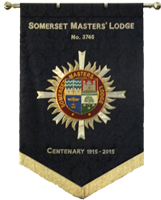Somerset Masters’ Lodge No. 3746 is unique within the Province of Somerset as membership is limited to Installed Masters. It does however welcome Master Masons to its meetings who are also welcome to join the Correspondence Circle of the Lodge and receive a copy of the Transactions which are published annually.
The purpose of the Lodge is:
• To provide a centre and bond on union for masonic students and brethren of literary tastes in and of the Province.
• To attract and interest brethren by means of papers on the history, antiquities and symbols of the Order and thus to augment their knowledge of Masonry.
• To generally cultivate masonic good fellowship and to promote the Grand Principles upon which our Order is founded.
The Lodge is thriving with over 300 full members and 40 members of the Correspondence Circle. The ‘home’ of the Lodge is at Bath where the Installation Meeting in February has been traditionally held, with a further meeting in October at the Taunton Masonic Hall. Additionally members, wives, partners and friends meet during the summer on an informal basis at a venue of the Master’s choice.
Formation
The idea of a Lodge of Installed Masters in Somerset had been on the minds of several prominent Somerset Freemasons at the beginning of the twentieth century, including the Provincial Grand Master, RW Bro Colonel William Long. Interest in forming this new lodge had followed from the formation of the noted Quatuor Coronati Lodge No 2076 in 1884, which was established as a Lodge for Brethren nationally with an interest in evidence-based Masonic research rather than on the imaginative writings of earlier authors.
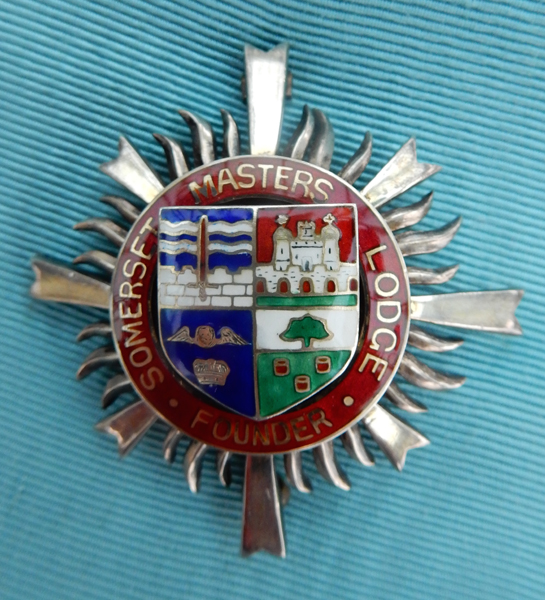
The Founder’s Jewel
A letter was sent to the Lodges in Somerset by W Bro George Norman asking Installed Masters in Somerset whether they wished to become a Founder of a new Lodge that would be for the members of Lodges in the Province of Somerset, and of the Somersetshire Lodge No. 2925, being Installed Masters. It was planned that whilst the headquarters of the Lodge would be in Bath, the meetings would move around the Province with three meetings a year: the last Monday in February (Installation), June and October. Approximately 100 brethren responded indicating they would be willing to be founders of the new Lodge.
Subsequently at an Emergency Meeting of The Royal Cumberland Lodge No. 41, which was held at the Masonic Hall, Bath on 26 June 1914 the minutes of the Lodge recorded:
”On a Motion proposed by W Bro G Norman and seconded by W Bro A G Day it was unanimously resolved that a recommendation in favour of a Past Masters’ Lodge for the Province of Somerset be made in accordance with Rule 116 of the Book of Constitutions and that the WM and Wardens be authorised to sign the necessary Petition.”
On 1 August 1914 Germany declared war with Russia. Two days later 1914 Germany declared war with France. Britain had a treaty with Belgium guaranteeing its neutrality. On 4 August 1914 German troops invaded Belgium. That day the British Government sent an ultimatum to Germany to withdraw their troops. The first reply from Germany was “unsatisfactory”. There was no reply to a second request. The British Government announced a state of war existed between Britain and Germany from 11.00 pm on 4 August 1914. As a result of the outbreak of the War it was decided to delay the formation of the new Lodge. Early in 1915 the Provincial Grand Master, Colonel William Long, thought it would be appropriate to apply for the Warrant, which was granted on 22 February 1915 and the Lodge was formally Consecrated in Bath on 22 April 1915.
The role of George Norman
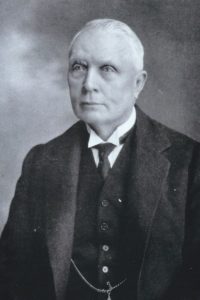
W Bro George Norman
The Provincial Grand Master, at the Luncheon preceding the Consecration Ceremony on 22 April 1915, said of George Norman, that the Lodge “owed its inception to this indefatigable and Masonic Student.” Born in 1849, George Norman had studied medicine at London and Edinburgh Universities and then travelled abroad before settling in Bath in 1876, where he remained in practice for 46 years. His Masonic career was exceptional and he enjoyed high office in a number of other Degrees and Orders. He was the Lodge Secretary of Somerset Masters for the first seven years and one of the joint Editors of the Transactions. He was very keen on Masonic research; became a prolific contributor to the Transactions of the Lodge; was invited to join the prestigious Quatuor Coronati Lodge and became its Master in 1923. In 1925, he donated many of his books on Masonry to the newly opened Library at the Masonic Hall in Bath, which is named after him.
Life in Bath in April 1915
The Bath and Wilts Chronicle reflected on the patriotic fever at that time with a whole page of photos of men who were joining up, but also obituaries of those who died fighting in France. In the newspaper there were recruitment adverts for the Army Service Corps, and in particular for Motor Drivers for the Shepton Mallet Barracks, butchers and bakers and for 100 men to join the Field Ambulance. The 10th Service Battalion of the Devon Regiment, who were based in Bath for their training, left Bath for their camp in Wiltshire prior to service in France. The Rev C Doudney, Vicar of St Luke’s, took the train for London en-route to the Front in France as an Army Chaplain. The Embroiderers Guild made 1000 bandages at the Guildhall on 23 April 1915.
Yet ordinary life carried on. There were reports of marriages and deaths, goods for sale, commercial adverts, court reports and there was an increase in Bread prices from 8p to 8½p due to the rising cost of flour, yeast, coal and wages. The Palace Theatre had a show called ‘Gentleman the King’, The Theatre Royal had a musical comedy called ‘The Girl in the Train’ and The Vaudeville Theatre was showing ‘Number 43’ a three-reel drama. There were also concerts at the Pump Room and refugees from Belgium gave a concert at the Roman Parade.
The Consecration Meeting
This was held at the noteworthy Assembly Rooms in Bath and the whole building, except for the Tea Room, was booked for the event. The Assembly Rooms had been completed in 1771 when they were described as “the most noble and elegant of any in the kingdom” the hub of fashionable Georgian society and a most suitable venue for this important meeting.
Luncheon was held in the Card Room at 1.30 pm with Col William Long CMG, Provincial Grand Master presiding. Col Long proposed the toast to the Consecrating Officers to which VW Bro Sir Edward Letchworth FSA, Grand Secretary, replied noting the last time he was in Bath six years ago when the Grand Master, HRH the Duke of Connaught, had also been present and he remembered the kind reception given to him on that occasion. The Rev Canon Macdonald then proposed the toast to the RW Provincial Grand Master who responded by expressing his appreciation on the work done by W Bro George Norman in founding the Lodge and said it was due to him that Sir Edward Letchworth was able to come to the Consecration meeting. Replying to the Toast of the WM designate, Col Alfred Thrale Perkins, said that this occasion was one which would be long remembered in Somerset as a very auspicious one indeed.
The Consecration ceremony was then held in the stately Ballroom, which had been prepared as a Lodge Room with furniture lent by the Bath Lodges. At the eastern end of the room a large platform had been erected for the seating of the Grand Officers which been tastefully carpeted. The addition of tall palms, acers and flowers created a pleasing atmosphere whilst the Union Jack and the flags of our Allies were displayed in the Minstrel Gallery adding colour and pageantry to the proceedings. The Vestibule and Octagon, used as lounges, were also filled with azaleas, cinerarias, golden yellow daffodils, palms and scarlet geraniums. The Club Room had been set aside for the Grand Officers and the mantlepieces were embellished with daffodils and salmon geraniums.
The Lodge opened at 3.00 pm. 189 masons were present of which 97 were Founders, plus 22 Grand Officers, 68 Visitors and 2 Tylers. The Consecrating Officer, VW Bro Sir Edward Letchworth FSA, Grand Secretary, entered the Lodge at 3.30 pm with his Grand Officers, who included W Bro P Colville-Smith PGD, DPGM Cornwall who acted as Senior Warden and W Bro William Hammond PGD who acted as Junior Warden. VW Bro Sir Edward Letchworth then expanded on the importance of the occasion, with it being one of the most interesting and solemn ceremonies connected with the Order. The Founders then stood in the body of the Lodge whilst the Director of Ceremonies read the Warrant and W Bro Rev W J L Phillips, Assistant Chaplain, PGChp Somerset, gave the Oration, which was “royally delivered and listened to with deep attention by the Brethren.” The Consecrating ceremony was then “perfectly” performed by VW Bro Sir Edward Letchworth and his Officers. A Masonic choir sang anthems and hymns during the meeting, which enhanced the occasion.
The VW Bro Sir Edward Letchworth, Grand Secretary, then installed Col Alfred Thrale Perkins as Master of the new Lodge and the Warrant of the Lodge was passed into his care. The Consecrating Officers were each presented with a Founders’ Jewel. The Worshipful Master then appointed and invested his Officers following which the Grand Secretary and his Officers retired from the Lodge in order for Sir Edward Letchworth to catch the train to London. The other business of the Lodge was then completed including the election of a Treasurer, the appointment and investiture of Officers, the election of a Tyler, and the nomination of a Committee to frame the By-laws. Alms amounted to £1 18 shillings. It was agreed that the next meeting would be at Weston-Super-Mare on 28 June 1915.
Both the Bath and Wilts Chronicle and the Bath Herald gave extensive reports of both the luncheon and the Consecration ceremony.
Masters of the Lodge
To be selected as Worshipful Master of the Lodge is a singular honour. Masters since 1915 have included Provincial Grand Masters, Deputy and Assistant Grand Masters and members who have given noteworthy service to the Lodge and the Province. Nine Provincial Grand Masters have been Masters namely the Venerable Archdeacon Walter Farrar in 1923, Brigadier General Claude Lumsden Norman DSO MVO DL 1940, Brigadier Arnold de Lerison Cazenove CBE DSO MVO DL 1965, Colonel Harry Owen Hughes OBE ED 1930, Kenneth Caswell Kinnersley 1973, Sir Walter Brett 1981, Stanley Herbert Ambrose Frank Hopkins 1990, David Lloyd Jenkins 1993 and Clarence Alfred Stuart Hadler 2014.
The Lodge Banner
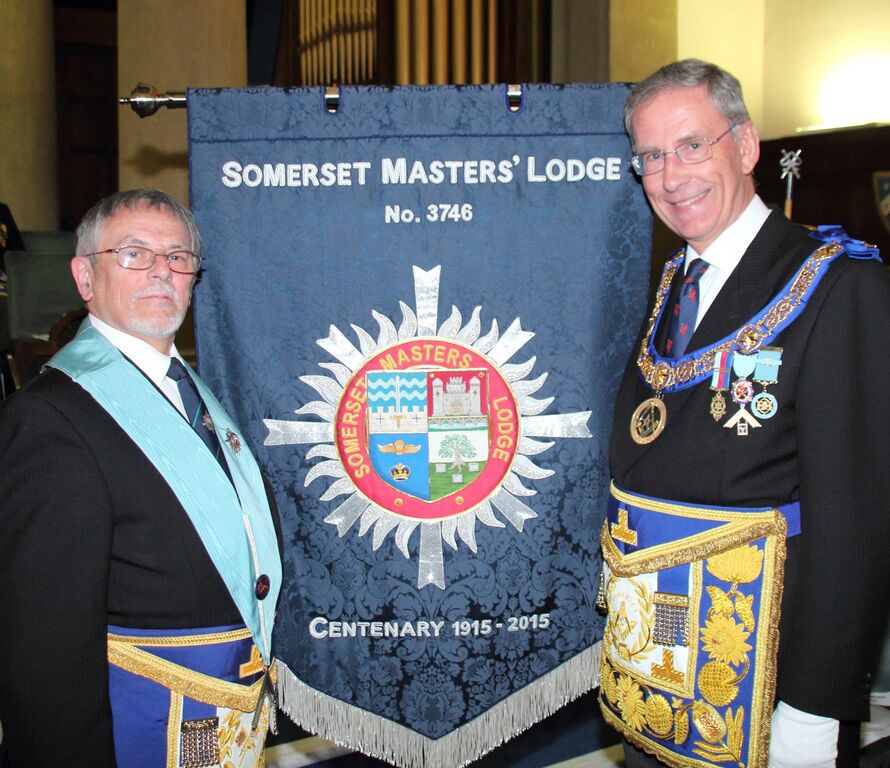
Provincial Grand Master RW Bro C A Stuart Hadler (right) presents the Lodge Banner to WM W Bro Pat Morrisey at the 2015 Centenary Meeting
Until the Centenary Meeting in 2015 the Somerset Masters’ Lodge was the only one in the Province without a Banner. The Founders Jewel, given to all 126 founders, provided the design for the new Banner, which was formally dedicated by the Provincial Master, R W Bro Stuart Hadler at the Centenary Meeting. The Banner is a composite of four elements taken from the Coats of Arms of Bridgwater, Wells, Taunton and Bath which are reflected in the Banners of four Somerset Lodges namely the Lodge of Perpetual friendship No 135, Benevolent Lodge No 446, The Lodge of Unanimity and Sincerity No 261 and the Lodge of Honour No 379.
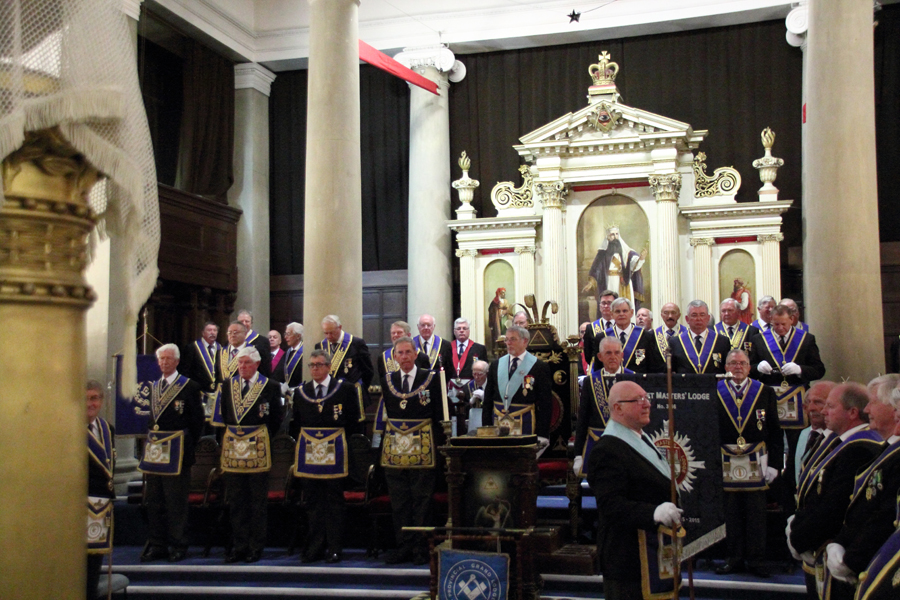
The Brethren prepare to retire from the Lodge at the end of the Centenary meeting in Bath
The Transactions and the Correspondence Circle
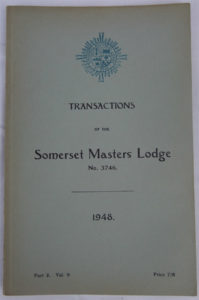 Two of the guiding principles of the Lodge have been to encourage an interest in Freemasonry in general and as a result the Correspondence Circle and publication of the Transactions were established in 1915, using the model of the premier research lodge, Quatuor Coronati No 2076.
Two of the guiding principles of the Lodge have been to encourage an interest in Freemasonry in general and as a result the Correspondence Circle and publication of the Transactions were established in 1915, using the model of the premier research lodge, Quatuor Coronati No 2076.
Papers read in the Lodge provided the contents of the early Transactions which soon expanded to include publication of material from members of any lodge or Chapter in the Province and later to those beyond the Province. The extensive range of topics and contributors is available from the Lodge Archivist and also on the internet. Noteworthy contributors include, Harry Carr, Bernard Jones, Roderick Baxter, Henry Lafontaine, Douglas Knoop, Ernest Cartwright, Terence Hauch, Percival James, Alexander Jackson, John Hamill, Yasha Beresiner, Cyril Bantham and Robert Gilbert.
Distribution of the Transactions is world-wide and has included: the District Grand Lodge of South America, The Grand Lodge of Free and Antient Freemasons in California, the Lodge Of Research Dublin No.200, Massachusetts Grand Lodge, Masonic Lodge of Research New Zealand, Pennsylvania Grand Lodge Library and Museum, Provincial Grand Lodge of Antrim, Supreme Council 33 ͦ Washington USA, plus many Masonic Libraries in this country.
The Meetings
The Installation Meeting is held in February when the new Worshipful Master also gives a talk on an aspect of research he has undertaken. In February 2017 W Bro Frank Clark’s presentation was “1717, Portrait of a Year – Turmoil and Change.” In October the focus of the meeting is a talk or presentation from a noteworthy person, which in recent years has included the Assistant Grand Master, The Grand Secretary, the Director of the Library and Museum at Freemasons Hall and several Prestonian Lecturers.
The Summer Visit

Summer Visit to Cothay Manor
Since 1920 there has been a summer visit, including ladies and friends, to an attraction in the South West. The first such visit was to the Abbey Ruins at Glastonbury when some 200 members and friends had lunch in the Abbots’ Kitchen and then at the Ruins where they received an inspirational address on Masonic Ideals, which was followed by tea served under the shade of the trees. Since then visits have included many National Trust Houses and Gardens, Dunster Castle, Sherborne Castle, Cothay Manor, Forde Abbey, Longleat House, Bristol Zoo, The West Somerset Railway from Bishops Lydeard to Minehead and to the River Dart in South Devon.
